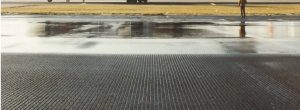^^^ Photo above: Showing grooved versus ungrooved surface when wet ^^^
Pilots need to know that when they land they can maintain maximum effective braking and a safe, uneventful landing despite the weather.
THE TESTS PROVE IT
In one of the tests by NASA, the landing research runway was divided into separate test sections and bound by 2-inch rubber dams to provide an even water depth. Braking was done for ground speeds ranging from about 50 to 150 knots. The tests involved accelerating to the desired speed from a standstill to the take-off position or landing short of the test section and adjusting speed. This speed, or a slightly higher speed, was held until about 100 yards before the appropriate test sections. At this point, power was reduced to idle and the spoilers extended.The timing allowed the engines to spin down to idle thrust before entering the test area. Brakes were abruptly applied to the maximum deflection while the wheels were still on the dry reference section and were maintained through two wet or flooded test surfaces, one grooved, and one ungrooved.
WHAT THEY FOUND
The transverse-grooved saw-cut surface provided impressive braking and the wheels could generate a side force to prevent lateral drift. Pilots found that deceleration on a wet, saw-cut grooved surface is almost the same as the dry surface and any nose-wheel steering lost on the ungrooved surface returns once braking resumes on the grooved surface. The test results indicate that when a runway is flooded, the saw-cut grooved surface provides better braking traction than an ungrooved surface.
This vital NASA research has led to the current Federal Aviation Administration (FAA) runway grooving configuration of ¼ inch by ¼ inch (groove depth and width), spaced 1 ½ inches center to center, which is utilized on most major runways in the United States.




